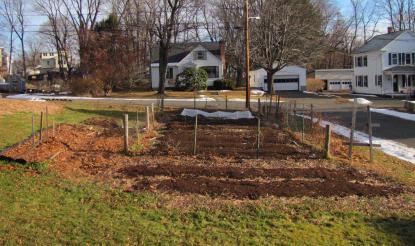We’ve had our first good snow or two, but a warm spell has left only a snowy patchwork. Two days before Christmas it rained all day so I opened up the hoop-hut to let some water in. For dinner I pulled a few carrots and radishes (we supplemented these meager provisions with the next assay in my pizza-crust experimentation). The carrots were sweet, but the radishes haven’t done as well.
Last year I envisioned building a much larger hoop house for this winter. It didn’t happen. I’ve actually got less protected space. I had too many things to do off-site this fall. My aspirations aren’t crushed just a bit mushed, maybe they’ll spring back come April. This year my semi-urban micro farm has not prospered, but we’ve done well enough and I guess that’s better than I expected.

As my reader may recall, I tried an experiment with onion husbandry. I germinated seeds in plastic six-packs, peat pots, or in soil blocks from my new soil block maker. Despite attacks from one of the household felines, the onions all grew well. However, the plants that started out in the soil blocks far outperformed the rest. Calling my experimental design “flawed” misleadingly dignifies it with the term “design.” Nevertheless, I’m sold on the soil blocks and will continue using them.
I grew only late blight resistant tomato seeds from Johnny’s this season. My favorites were the Plum Regals, a determinant sauce tomato. The Regal’s resistance to late blight meant I got my first good sauce production in several years. We ate our final jar on the aforementioned pizza. Cherry tomatoes always do pretty well, but the Jasper variety I grew this year was a real standout. They didn’t stop producing until the frost and I don’t think they even got hit by the ever present septoria leaf spot. Septoria doesn’t destroy crops the way the late blight does, but it cuts yield. Next year I’m going to try mulching my tomatoes in plastic. I’ve always resisted this, because of the waste, but I think it will dramatically cut down on disease inoculation.
My blueberries have never done very well, but this season my plants started to clearly separate into a group that is going to make it and 3 or 4 that just aren’t. Among the ones that are going to make it is a single plant that produced a good harvest. I’m not suggesting that the blueberries made it in the house, they didn’t, but they were delicious. This spring I’m going to cull.
Speaking of culling, the chickens have not had good year. We inflicted a few significant stressors on them: noisy construction and a strange new hen. Right now I have eight hens and am lucky to get two eggs a day. This is no way to run a semi-urban micro farm. Perhaps I need to organize a chicken Hunger-Games®. I’ll pick tributes and force them to fight to the death in an arena. The one who survives will get to live in an alcohol fueled stupor for the rest of her life. Yeah, the book didn’t make much sense either. More likely I’ll just get new chickens and give the hens I have to some city-slicker who wants to raise chickens. Sucker.
A good friend of mine spent a few years working with schools that include a farming component. He’s a math teacher, but often gets involved in agricultural pursuits. He’s written a song called “F.A.R.M,” or Fix Another Ridiculous Machine. The hook is “down on the farm where everything is broke.” Of course a big factory farm probably runs efficiently, and for all I know even the small farms in our valley work this way. But for my semi-urban micro-farm, it’s all about the process, and most of the time a lot of things aren’t working right. I can’t wait for spring.


